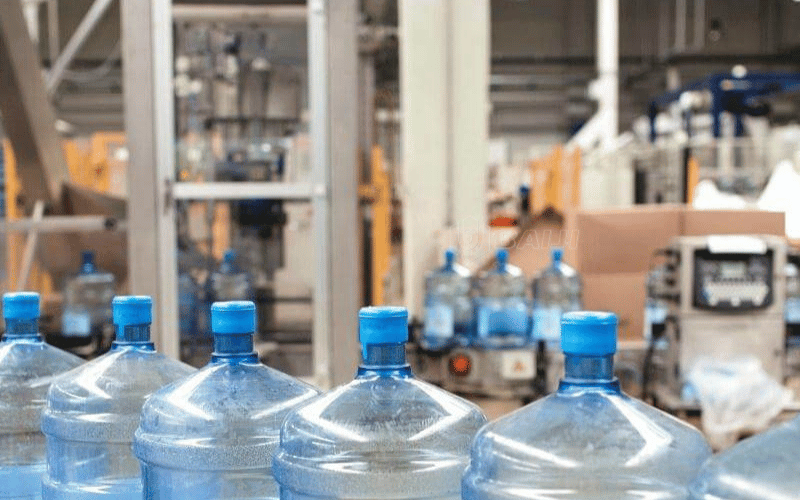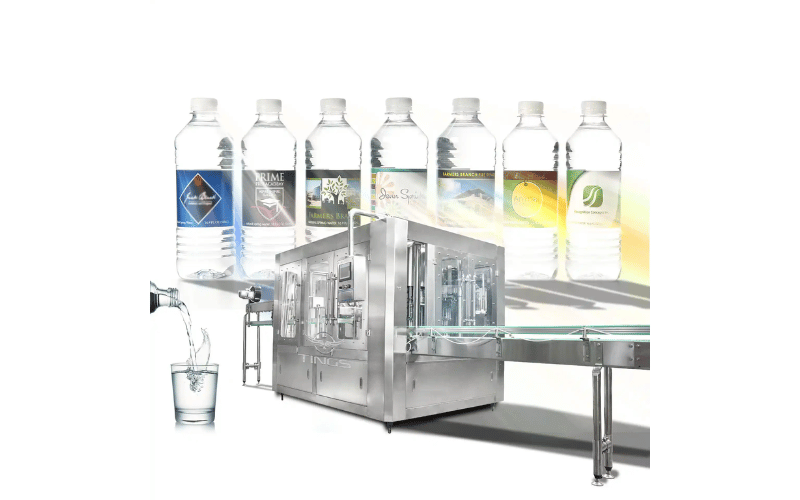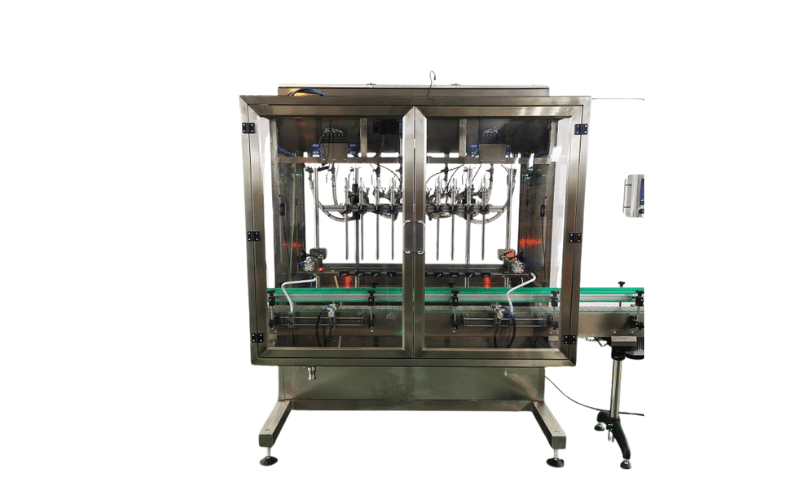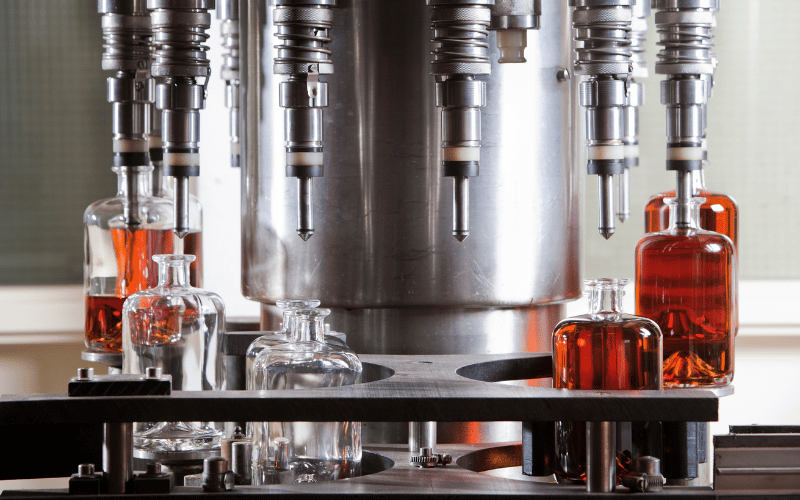Оглавление
ToggleВведение
Машины для розлива воды в бутылки играют важнейшую роль в индустрии напитков, обеспечивая быстрое, точное и гигиеничное производство. Эти машины оптимизируют рабочие процессы, удовлетворяют потребности в больших объёмах и обеспечивают целостность продукции, что делает их незаменимыми для производителей. Выбор правильного оборудования повышает эффективность, сокращает отходы и обеспечивает стабильное качество, давая компаниям конкурентное преимущество на требовательном рынке.
Понимание систем наполнения бутылок с водой
Системы розлива воды в бутылки являются основой процесса производства напитков, обеспечивая эффективный, точный и гигиеничный розлив. Эти системы выполняют важнейшую задачу перекачки воды из резервуаров в бутылки, соблюдая строгие стандарты качества и безопасности. Автоматизируя различные этапы производства, они помогают производителям удовлетворять большие объемы спроса, снижать эксплуатационные расходы и обеспечивать стабильные результаты. Их роль выходит за рамки простого розлива в бутылки; они оптимизируют весь процесс розлива, обеспечивая бесперебойность работы от начала до конца.
Ключевые компоненты систем наполнения бутылок с водой
Очистительные устройства: обеспечение гигиены и безопасности
Очистительные установки – это первый этап процесса розлива, где они подготавливают тару к наполнению, удаляя такие загрязнения, как пыль, мусор и остатки. В этих установках часто используются струи воды под высоким давлением, ополаскивание воздухом или методы стерилизации для обеспечения соответствия бутылок гигиеническим стандартам. Правильная очистка не только сохраняет качество продукта, но и предотвращает загрязнение, которое может поставить под угрозу безопасность потребителя. Современные системы могут включать автоматизированные циклы очистки, что снижает необходимость ручного вмешательства и обеспечивает стабильные результаты.
Механизмы наполнения: точность и скорость
Механизм розлива – это основа любой системы розлива воды в бутылки. Он точно контролирует подачу воды в бутылки, обеспечивая точный уровень наполнения и минимизируя отходы. Различные системы, такие как гравитационный розлив, розлив под давлением или изобарический розлив, удовлетворяют различным производственным потребностям. Например, гравитационный розлив хорошо подходит для негазированной воды, а изобарический – для газированных напитков. Современные механизмы розлива часто включают в себя датчики и автоматизированные системы управления для поддержания однородности и адаптации к различным размерам бутылок или скорости производства.
Системы укупорки: защита продукта
Системы укупорки обеспечивают надёжную герметизацию каждой бутылки, сохраняя свежесть продукта и предотвращая протечки. Эти системы работают с различными типами крышек, включая винтовые, защёлкивающиеся и спортивные, в зависимости от продукта и дизайна упаковки. Автоматизированные укупорочные машины точно выравнивают и устанавливают крышки, обеспечивая герметичность без повреждения бутылки или крышки. Некоторые системы также оснащены функцией контроля крутящего момента для обеспечения равномерной герметизации всех бутылок, что повышает надёжность продукта.
Маркировочные единицы: улучшение презентации бренда
Этикетировочные устройства наносят этикетки на бутылки, играя ключевую роль в брендинге и коммуникации с потребителями. Эти устройства выполняют такие задачи, как выравнивание этикеток, нанесение клея и обеспечение их правильного размещения на бутылке. Современные этикетировочные системы могут работать с различными типами этикеток, например, термоусадочные рукава, самоклеящиеся этикетки или этикетки-обертки, обеспечивающие гибкость для различных вариантов упаковки. Точная и однородная маркировка повышает визуальную привлекательность продукта и обеспечивает соответствие нормативным требованиям.
Конвейерные системы: оптимизация производственного потока
Транспортные системы соединяют все компоненты воды процесс наполнения бутылок, обеспечивая бесперебойный поток бутылок с одного этапа на другой. Эти системы используют конвейерные ленты, направляющие и передаточные механизмы для эффективного перемещения бутылок через этапы мойки, розлива, укупорки и этикетирования. Поддерживая постоянный темп производства, конвейерные системы сокращают количество узких мест и оптимизируют общую эффективность. Некоторые системы также оснащены датчиками для обнаружения заторов или перекосов бутылок, что позволяет операторам быстро устранять проблемы и поддерживать бесперебойную работу.
Благодаря интеграции этих ключевых компонентов системы розлива воды в бутылки представляют собой комплексное решение для эффективного и высококачественного производства. Каждый компонент играет важнейшую роль в обеспечении соответствия конечного продукта отраслевым стандартам и ожиданиям потребителей, что делает эти системы незаменимыми для современных производителей напитков.

Ключевое оборудование в системе розлива воды
Система розлива воды использует комплекс специализированного оборудования для обеспечения эффективности, гигиеничности и высокого качества производства. Каждый элемент оборудования играет свою роль в процессе: от подготовки бутылок до их укупорки и маркировки. Ниже мы рассмотрим основное оборудование, используемое в системах розлива воды, и его вклад в оптимизацию рабочих процессов.
Машины для мойки бутылок: обеспечение гигиены и безопасности
Машины для мойки бутылок подготавливают тару к розливу, удаляя загрязнения, такие как пыль, мусор и остатки. Этот этап критически важен для обеспечения безопасности и качества продукции, особенно в таких отраслях, как производство напитков, где строгие гигиенические стандарты. Моечные машины используют такие методы, как ополаскивание водой под высоким давлением, струи воздуха или стерилизация, чтобы гарантировать отсутствие загрязнений в бутылках.
Современные системы очистки часто включают автоматизированные циклы, которые сокращают ручной труд и повышают стабильность. Некоторые машины также оснащены многоэтапными процессами очистки, сочетающими ополаскивание, стерилизацию и сушку, что обеспечивает соответствие самым высоким гигиеническим требованиям. Гарантируя тщательную очистку бутылок, эти машины защищают продукт от загрязнения и повышают доверие потребителей.
Машины для розлива жидкостей: точность для жидкостей с низкой вязкостью
Машины для розлива жидкостей выполняют основную задачу — точно и быстро переливают воду в бутылки. Эти машины разработаны для работы с жидкостями низкой вязкости, такими как вода, обеспечивая точный уровень наполнения и минимизируя отходы. типы разливочных машин удовлетворять различные производственные потребности:
- Гравитационные разливочные машины: Эти системы идеально подходят для негазированной воды. Они используют силу гравитации для перекачивания жидкости в бутылки, предлагая простое и экономичное решение.
- Изобарические разливочные машины: Эти машины подходят для газированной воды и используют выравнивание давления для предотвращения пенообразования и поддержания уровня углекислого газа.
- Машины для объемного розлива: Эти системы измеряют и дозируют точные объемы, обеспечивая одинаковый уровень наполнения во всех бутылках.
Современные машины для розлива часто оснащены датчиками и автоматизированными системами управления, позволяющими адаптироваться к различным размерам бутылок и скоростям производства, что повышает эффективность и сокращает количество ошибок.
Укупорочные машины: защита продукта
Укупорочные машины Обеспечивают надежную герметизацию каждой бутылки, сохраняя свежесть и предотвращая протечки. Эти машины работают с различными типами крышек, включая винтовые, защелкивающиеся и спортивные, в зависимости от продукта и дизайна упаковки. Автоматизированные системы укупорки точно выравнивают и устанавливают крышки, обеспечивая герметичность без повреждения бутылки или крышки.
Вспомогательное оборудование, такое как сортировщики крышек и подъемники, оптимизирует процесс укупорки, сортируя и подавая крышки в машину. Некоторые системы также включают в себя контроль крутящего момента для обеспечения равномерной герметизации, повышая надежность продукции и удовлетворенность потребителей.
Конвейеры: оптимизация производственного потока
Конвейеры играют важнейшую роль в транспортировке бутылок на каждом этапе производственной линии. Эти системы используют ремни, направляющие и передаточные механизмы для эффективного перемещения бутылок от мойки до розлива, укупорки и этикетирования. Поддерживая постоянный темп производства, конвейеры сокращают количество узких мест и оптимизируют рабочий процесс.
Современные конвейерные системы оснащены такими функциями, как регулировка скорости, датчики обнаружения заторов и автоматическое распределение бутылок для обеспечения бесперебойной работы. Некоторые системы также подходят для бутылок разных размеров и форм, обеспечивая гибкость для различных линеек продукции.
Этикетировочные машины: улучшение брендинга и коммуникации
Этикетировочные машины наносят этикетки на бутылки, выполняя как функциональные, так и брендинговые функции. Эти машины выполняют такие задачи, как выравнивание этикеток, нанесение клея и обеспечение их правильного размещения на бутылке. Точная маркировка повышает визуальную привлекательность продукта и содержит важную информацию, такую как состав, срок годности и название бренда.
Современные этикетировочные системы поддерживают различные типы этикеток, включая термоусадочные рукава, самоклеящиеся этикетки и самоклеящиеся этикетки, обеспечивая гибкость для различных вариантов упаковки. Некоторые машины также оснащены системами контроля для выявления смещенных или дефектных этикеток, что гарантирует безупречное качество конечного продукта.
Благодаря интеграции этих ключевых компонентов оборудования системы розлива воды обеспечивают эффективное и высококачественное производство, отвечая отраслевым стандартам и ожиданиям потребителей. Каждый компонент вносит свой вклад в обеспечение бесперебойного процесса, гарантируя производителям возможность выпускать безопасную, надежную и визуально привлекательную продукцию.
Типы наполнителей для машин для розлива воды в бутылки
Машины для розлива воды в бутылки используют разные типы наполнителей для обработки различных жидкостей. вязкость жидкости, конструкции ёмкостей и производственные требования. Каждый тип наполнителя обладает уникальными преимуществами, поэтому важно выбрать подходящий именно вам. Ниже мы рассмотрим наиболее распространённые типы наполнителей, используемых в системах розлива воды в бутылки, и их применение.
Гравитационные наполнители: простые и экономичные для жидкостей с низкой вязкостью
Гравитационные разливочные системы представляют собой эффективное и простое решение для розлива маловязких жидкостей, таких как вода. Эти системы используют силу гравитации для перекачки жидкости из накопительного бака в бутылки, что делает их идеальными для негазированных напитков и других текучих жидкостей. Простота работы гравитационных разливочных систем снижает требования к техническому обслуживанию и обеспечивает экономическую эффективность, что делает их популярным выбором для предприятий малого и среднего бизнеса.
Эти дозаторы лучше всего подходят для ёмкостей одинаковой формы и размера, поскольку гравитационный механизм обеспечивает равномерный уровень наполнения. Хотя они не обладают такой же скоростью и универсальностью, как более современные системы, гравитационные дозаторы превосходны в плане надёжной работы в простых условиях. Низкие эксплуатационные расходы и простота использования делают их отличным вариантом для компаний, стремящихся оптимизировать эффективность без значительных инвестиций.
Насосные наполнители: универсальные для различных вязкостей
Насосные разливочные машины отличаются своей универсальностью, позволяя работать с жидкостями различной вязкости: от воды до более густых веществ, таких как сиропы или масла. Эти системы используют насосы для перекачки жидкости в ёмкости, обеспечивая точный контроль объёма и скорости наполнения. Благодаря своей гибкости, насосные разливочные машины подходят для различных типов ёмкостей, включая бутылки с необычной формой или узким горлышком.
Производители могут выбирать различные типы насосов, такие как шестерёнчатые, мембранные или перистальтические, в зависимости от своих конкретных потребностей. Например, перистальтические насосы хорошо подходят для высокочувствительных жидкостей, поскольку они минимизируют риск загрязнения, изолируя продукт от механизма насоса. Насосные разливочные машины также поддерживают регулируемые настройки, что позволяет операторам переключаться между продуктами или размерами ёмкостей с минимальным временем простоя.
Наполнители с переливом под давлением, гравитацией и вакуумом: точность для жидкостей низкой и средней вязкости
Наполнители с переливом под давлением, гравитацией и вакуумом предлагают передовые решения для розлива жидкостей низкой и средней вязкости. Эти системы обеспечивают постоянный уровень наполнения, позволяя излишкам жидкости переливаться обратно в резервуар, что делает их идеальным решением для продуктов, требующих точного контроля объема.
- Наполнители с переливом под давлением: Эти системы используют положительное давление для подачи жидкости в контейнеры, обеспечивая быстрое и точное наполнение. Они хорошо подходят для жидкостей средней вязкости и часто используются на высокоскоростных производственных линиях.
- Гравитационные наполнители с переливом: Подобно стандартным гравитационным наполнителям, эти системы работают под действием силы тяжести, но оснащены механизмом перелива для поддержания постоянного уровня наполнения. Они лучше всего подходят для жидких жидкостей, таких как вода или сок.
- Вакуумные переливные наполнители: Эти наполнители создают вакуум для наполнения ёмкостей жидкостью, что делает их идеальными для компактных бутылок или бутылок нестандартной формы. Вакуумный механизм обеспечивает чистое и точное наполнение, уменьшая количество проливаний и отходов.
Каждый из этих переливных наполнителей обладает уникальными преимуществами, позволяя производителям выбирать систему, которая наилучшим образом соответствует их производственным целям и характеристикам продукта.
Понимая возможности и области применения этих типов наполнителей, компании могут выбрать наиболее подходящую систему для розлива воды в бутылки. Независимо от того, ставите ли вы приоритеты экономичность, универсальность или точность, правильный наполнитель обеспечивает бесперебойное производство, стабильное качество и оптимальную производительность.
Факторы, которые следует учитывать при выборе машины для розлива воды в бутылки
Выбор подходящего оборудования для розлива воды в бутылки требует тщательного анализа ряда факторов, чтобы убедиться, что оно отвечает вашим производственным потребностям, обеспечивает высокое качество продукции и соответствует вашему бюджету. Ниже мы рассмотрим ключевые моменты, которые могут помочь вам принять решение.
Объем производства: соответствие производительности машины потребностям бизнеса
Понимание объёма производства критически важно при выборе фасовочного оборудования. Оборудование различается по производительности: от небольших моделей для стартапов до высокоскоростных систем, предназначенных для крупномасштабного производства. Переоценка или недооценка производственных потребностей может привести к неэффективности или ненужным затратам.
Для предприятий с высокими производственными требованиями инвестиции в высокопроизводительное оборудование обеспечивают бесперебойную работу и предотвращают возникновение узких мест. С другой стороны, предприятиям меньшего размера могут быть полезны компактные и экономичные машины, способные обрабатывать умеренные объёмы без перегрузки ресурсов. Всегда учитывайте будущий рост при оценке производственных мощностей, чтобы избежать частой модернизации.
Вязкость жидкости: выбор правильного наполнителя для воды и других жидкостей
Вязкость жидкости, которую вы планируете разливать, играет важную роль в определении типа необходимого вам наполнителя. Вода, будучи маловязкой жидкостью, хорошо подходит для гравитационных наполнителей или наполнителей с переливом, которые обеспечивают точность и эффективность. Однако, если ваша линейка продукции включает жидкости с различной вязкостью, например, соки или сиропы, вам может потребоваться более универсальная система, например, наполнитель с помпой.
Выбор машины, соответствующей вязкости вашей жидкости, обеспечивает точный уровень розлива, сокращает количество отходов и предотвращает эксплуатационные проблемы. Некоторые современные машины предлагают регулируемые настройки для работы с различными типами жидкостей, что делает их идеальным выбором для компаний с разнообразной линейкой продукции.
Типы контейнеров: совместимость с бутылками разных размеров и материалов
Конструкция, размер и материал бутылок напрямую влияют на выбор типа разливочной машины. Для обеспечения бесперебойной работы машины должны учитывать конкретные размеры и форму тары. Например, для бутылок с узким горлышком могут потребоваться специальные насадки, а для тары нестандартной формы — специальные конвейерные системы.
Кроме того, учитывайте материал ваших бутылок. Машины, предназначенные для пластиковых бутылок, могут работать неэффективно со стеклянной или металлической тарой. Выбор машины с регулируемыми компонентами или модульной конструкцией позволит вам переключаться между различными типами тары без значительного простоя, обеспечивая гибкость для будущих изменений продукции.
Бюджет и экономическая эффективность: баланс первоначальных инвестиций с долгосрочными выгодами
Хотя первоначальная стоимость оборудования для розлива воды в бутылки играет важную роль, важно оценить долгосрочные преимущества и экономию на эксплуатационных расходах, которые оно может обеспечить. Высококачественные машины могут потребовать больших первоначальных вложений, но со временем они часто обеспечивают более высокую эффективность, долговечность и меньшие затраты на обслуживание.
При оценке экономической эффективности учитывайте такие факторы, как энергопотребление, требования к техническому обслуживанию и возможное время простоя. Оборудование с передовыми функциями автоматизации может снизить затраты на рабочую силу и повысить производительность, обеспечивая более высокую окупаемость инвестиций. Правильный баланс между доступностью и производительностью обеспечит устойчивый рост вашего бизнеса.
Гигиена и устойчивость к коррозии: обеспечение соответствия стандартам безопасности
Соблюдение гигиены критически важно при розливе воды, поскольку загрязнение может поставить под угрозу безопасность продукта и репутацию бренда. Выбирайте оборудование из материалов, предназначенных для пищевой промышленности, таких как нержавеющая сталь, которая устойчива к коррозии и легко моется. Такие функции, как система безразборной мойки (CIP), упрощают обслуживание и гарантируют соблюдение гигиенических норм.
Коррозионная стойкость не менее важна, особенно если ваше производство связано с кислотными или богатыми минералами жидкостями. Оборудование с защитными покрытиями или коррозионно-стойкими компонентами продлевает срок службы оборудования и снижает риск загрязнения. Приоритетное внимание к гигиене и долговечности гарантирует соответствие вашего производства нормативным требованиям и выпуск безопасной и высококачественной продукции.
Тщательно рассмотрев эти факторы, вы сможете выбрать машину для розлива воды в бутылки, которая будет соответствовать вашим производственным целям, повысит эффективность и будет способствовать долгосрочному успеху вашего бизнеса.
Преимущества современных машин для розлива воды в бутылки
Современные машины для розлива воды в бутылки обладают рядом преимуществ, которые помогают компаниям оптимизировать свою деятельность, повышать качество продукции и соответствовать отраслевым стандартам. Благодаря передовым технологиям и автоматизации эти машины решают проблемы традиционных систем, обеспечивая при этом ощутимые преимущества. Ниже мы рассмотрим основные преимущества использования современного оборудования для розлива.
Повышение эффективности и сокращение отходов
Современные разливочные машины значительно повышают эффективность производства за счёт автоматизации ключевых процессов, таких как очистка, розлив, укупорка и этикетирование. Эти системы работают на высокой скорости, позволяя производителям удовлетворять потребности крупномасштабного производства без ущерба для точности. Расширенные функции, такие как автоматическая регулировка и мониторинг в режиме реального времени, обеспечивают бесперебойную работу, минимизируя простои и узкие места.
Помимо повышения эффективности, эти машины сокращают отходы, обеспечивая точный уровень наполнения и минимизируя проливы. Датчики и системы управления контролируют процесс наполнения, предотвращая перелив или недолив, которые могут привести к потере продукции или несоответствию качества упаковки. Оптимизируя использование ресурсов, компании могут снизить эксплуатационные расходы и повысить устойчивость.
Улучшенное качество и постоянство продукции
Поддержание стабильного качества продукции имеет решающее значение для укрепления доверия потребителей и лояльности к бренду. Современные машины для розлива воды в бутылки используют передовые технологии, обеспечивающие равномерный уровень наполнения, надежную герметизацию и точную маркировку всех бутылок. Автоматизированные системы исключают человеческий фактор, снижая риск возникновения дефектов или несоответствий, которые могут негативно сказаться на качестве конечного продукта.
Некоторые машины также оснащены интегрированными системами инспекции, которые выявляют и отбраковывают дефектные бутылки до их выхода на рынок. Эти системы контролируют такие факторы, как объём наполнения, выравнивание крышки и расположение этикетки, гарантируя соответствие каждого продукта стандартам качества. Обеспечивая надёжные и высококачественные результаты, современные машины розлива помогают компаниям сохранять конкурентоспособность.
Масштабируемость для растущего бизнеса
По мере расширения бизнеса производственные потребности часто растут, что требует оборудования, масштабируемого по мере роста спроса. Современные машины для розлива воды в бутылки отличаются гибкостью и масштабируемостью, позволяя производителям регулировать скорость производства, работать с бутылками разных размеров и работать с различными линейками продукции. Модульная конструкция и настраиваемые функции позволяют легко модернизировать или перенастраивать машины по мере изменения производственных требований.
Например, компании могут добавлять дополнительные разливочные головки или интегрировать новые компоненты, такие как усовершенствованные системы укупорки, для увеличения производительности. Такая масштабируемость позволяет производителям удовлетворять растущий потребительский спрос без необходимости приобретения совершенно нового оборудования, что экономит время и ресурсы в долгосрочной перспективе.
Соблюдение норм гигиены и безопасности
Гигиена и безопасность остаются главными приоритетами в индустрии розлива воды, и современные машины для розлива разработаны с учетом строгих нормативных требований. В этих машинах используются материалы, совместимые с пищевыми продуктами, такие как нержавеющая сталь, которая устойчива к коррозии и легко моется. Такие функции, как система безразборной мойки (CIP), упрощают обслуживание, обеспечивая тщательную очистку без разборки оборудования.
Усовершенствованные механизмы герметизации и системы предотвращения загрязнения дополнительно повышают безопасность продукции, защищая потребителей и поддерживая репутацию бренда. Соответствуя стандартам гигиены и безопасности, современные разливочные машины помогают компаниям избегать штрафных санкций и сохранять доверие к своей продукции.
Используя преимущества современных машин для розлива воды в бутылки, компании могут повысить эффективность, обеспечить стабильное качество и масштабировать производство для удовлетворения будущих потребностей. Эти системы не только повышают производительность, но и способствуют долгосрочному росту и устойчивому развитию.
Распространенные проблемы и решения
На предприятиях по розливу воды в бутылки часто возникают проблемы, которые могут нарушить производственный процесс, повлиять на качество продукции и увеличить затраты. Эффективное решение этих проблем обеспечивает более стабильную работу и долгосрочный успех. Ниже мы рассмотрим распространённые проблемы в отрасли и практические способы их решения.
Проблемы с обслуживанием и простоями
Частые технические работы и непредвиденные простои могут существенно повлиять на производственные графики и рентабельность. Оборудование со сложными компонентами или устаревшими технологиями часто требует более частого ремонта, что приводит к задержкам и увеличению эксплуатационных расходов. Кроме того, незапланированные поломки могут нарушить цепочки поставок и снизить общую эффективность.
Для решения этих проблем компаниям следует инвестировать в современные разливочные машины, оснащенные функциями предиктивного обслуживания. Эти системы используют датчики и мониторинг в режиме реального времени для выявления потенциальных проблем до их обострения, что позволяет операторам заблаговременно планировать техническое обслуживание. Регулярное обучение персонала правильной эксплуатации и обслуживанию машин также минимизирует износ и снижает вероятность поломок. Отдавая приоритет профилактическим мерам, компании могут свести к минимуму время простоя и поддерживать стабильный уровень производства.
Проблемы контроля качества
Обеспечение стабильного качества продукции остаётся главным приоритетом для производителей, но достижение этой цели может быть непростой задачей. Такие факторы, как неточный уровень наполнения, неровные крышки или дефектные этикетки, могут негативно сказаться на качестве конечного продукта, что приводит к недовольству клиентов и потенциальным отзывам продукции. Ручной контроль качества часто не позволяет выявить все дефекты, особенно в условиях высокоскоростного производства.
Современные системы розлива решают эти проблемы благодаря интегрированным функциям контроля качества. Автоматизированные системы инспекции отслеживают критически важные параметры, такие как объём наполнения, выравнивание крышки и размещение этикетки, в режиме реального времени. Эти системы выявляют и удаляют дефектные бутылки с производственной линии, гарантируя, что потребителям попадёт только высококачественная продукция. Кроме того, компании могут регулярно внедрять аудиты и протоколы контроля качества для поддержания высоких стандартов и укрепления доверия потребителей.
Управление расходами и обновлениями
Для многих производителей поиск баланса между эксплуатационными расходами и необходимостью модернизации представляет собой серьёзную проблему. Старые машины могут иметь меньшие первоначальные затраты, но со временем они часто требуют более высоких расходов на обслуживание и энергопотребление. С другой стороны, переход на современные системы требует значительных первоначальных инвестиций, что может обременить бюджет.
Для эффективного управления расходами компаниям следует оценить долгосрочные преимущества современного оборудования. Энергоэффективное оборудование и автоматизированные функции снижают эксплуатационные расходы и затраты на рабочую силу, обеспечивая более высокую окупаемость инвестиций. Варианты лизинга или финансирования также могут сделать модернизацию более доступной, распределив затраты во времени. Кроме того, модульные системы позволяют компаниям добавлять новые компоненты или функции по мере необходимости, обеспечивая гибкость без необходимости полной модернизации.
Решая эти общие проблемы с помощью проактивных стратегий и современных технологий, производители могут оптимизировать операции по розливу воды в бутылки, повысить качество продукции и эффективно контролировать затраты.
Будущие тенденции в технологии розлива воды в бутылки
Индустрия розлива воды в бутылки продолжает развиваться благодаря технологическому прогрессу и растущему спросу на экологичные и эффективные решения. Производители внедряют инновационные подходы для повышения производительности, снижения воздействия на окружающую среду и удовлетворения ожиданий потребителей. Ниже мы рассмотрим ключевые тенденции, определяющие будущее технологий розлива воды в бутылки.
Интеграция ИИ и Интернета вещей для мониторинга в реальном времени
Искусственный интеллект (ИИ) и Интернет вещей (ИВ) трансформируют системы розлива воды в бутылки, обеспечивая мониторинг в режиме реального времени и принятие решений на основе данных. Датчики ИВ собирают данные о производительности оборудования, уровнях наполнения и скорости производства, предоставляя операторам полезную информацию для оптимизации работы. Алгоритмы ИИ анализируют эти данные, чтобы прогнозировать потенциальные проблемы, такие как неисправности оборудования или несоответствия в уровнях наполнения, что позволяет компаниям устранять проблемы до того, как они нарушат производственный процесс.
Эти технологии также улучшают контроль качества, выявляя дефекты в режиме реального времени. Например, системы машинного зрения на базе искусственного интеллекта могут обнаруживать смещенные крышки, неправильные этикетки или неполные бутылки, гарантируя, что потребителям попадут только высококачественные продукты. Интеграция искусственного интеллекта и Интернета вещей позволяет производителям повысить эффективность, сократить количество отходов и поддерживать стабильное качество продукции, одновременно минимизируя время простоя.
Устойчивые и экологичные решения для розлива
В связи с растущей обеспокоенностью по поводу окружающей среды отрасль переходит к устойчивым и экологичным решениям для розлива. Производители внедряют энергоэффективное оборудование, потребляющее меньше энергии и сокращающее выбросы углерода. В некоторых системах теперь используются передовые технологии, такие как сервоприводы, которые оптимизируют энергопотребление без ущерба для производительности.
Помимо энергоэффективности, компании ищут способы минимизировать отходы материалов. Машины, разработанные для лёгких бутылок и перерабатываемых материалов, помогают сократить использование пластика, что соответствует глобальным целям устойчивого развития. Водосберегающие функции, такие как системы ополаскивания замкнутого цикла, дополнительно повышают экологичность, экономя ресурсы в процессе очистки. Отдавая приоритет устойчивому развитию, производители не только уменьшают своё воздействие на окружающую среду, но и привлекают экологически сознательных потребителей.
Расширенная автоматизация для повышения эффективности
Автоматизация продолжает играть ключевую роль в развитии технологий розлива воды в бутылки. Современные системы оснащены передовыми функциями автоматизации, которые оптимизируют производство, снижают трудозатраты и повышают точность. Например, роботизированные манипуляторы с высокой точностью выполняют такие задачи, как размещение бутылок, укупорка и маркировка, обеспечивая стабильные результаты на высокой скорости.
Автоматизированные системы также обеспечивают большую гибкость, позволяя производителям переключаться между различными размерами, формами бутылок и типами продукции с минимальным временем простоя. Такие функции, как программируемые логические контроллеры (ПЛК) и человеко-машинные интерфейсы (ЧМИ), позволяют операторам быстро настраивать параметры и контролировать производительность в режиме реального времени. С развитием технологий автоматизации предприятия могут добиться более высоких показателей производительности, снижения эксплуатационных расходов и лучшей адаптации к требованиям рынка.
Принимая эти будущие тенденции, индустрия розлива воды в бутылки готова предложить более интеллектуальные, экологичные и эффективные решения. Эти инновации не только решают текущие проблемы, но и закладывают основу для устойчивого роста и технологического совершенства в ближайшие годы.
Заключение
Выбор правильной воды машина для наполнения бутылок Играет решающую роль в обеспечении эффективности, качества продукции и операционного успеха. Оценивая производственные потребности и инвестируя в современные системы, компании могут повысить производительность, сократить отходы и подготовиться к устойчивому и долгосрочному росту.





